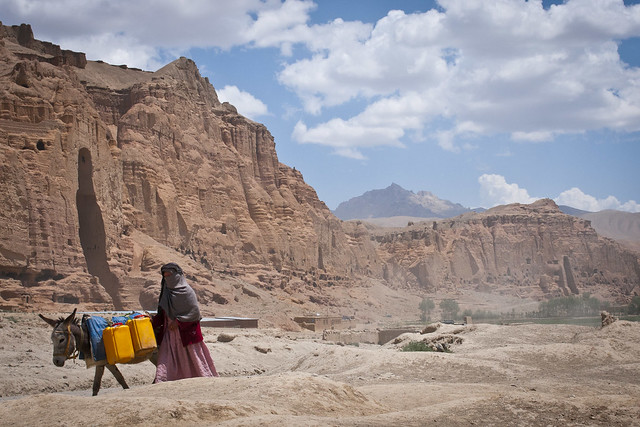As one of Afghanistan’s two official World Heritage Sites, the Bamiyan Valley contains cultural and archaeological remains which make it a treasure to be safeguarded. Unfortunately, the site’s most famous cultural asset—the two colossal Buddha sculptures carved into the cliffs of the valley—was destroyed in 2001.
However, many efforts have been made since that time to preserve other aspects of the site. Today, an extensive rehabilitation plan, which includes the creation of a brand new cultural center, is currently in development.
The Site Remains Vulnerable
Despite these positive steps forward, the Bamiyan Valley remains vulnerable to threats such as environmental damage and security risks. This has resulted in its inclusion on a number of “at risk” lists, notably the list of World Heritage in Danger and the World Monuments Fund’s Watch List. Before the site can be removed from these lists, there is still a great deal of work to be done.
This question of what to do to ensure a safe and protected future for the Bamiyan Valley was the central focus of a recent three-day technical meeting. The event was organized jointly by UNESCO, the government of Afghanistan, and several other international partners. It was financially supported by the government of Japan.

International Efforts to Reinvigorate the Site
Held in December 2018, the meeting brought national and international experts together in Salah, Oman. The result was three productive days of dialogue and strategizing about the future of the Bamiyan World Heritage site.
Meeting participants also went on field visits to several Omani heritage properties, including the Land of Frankincense World Heritage site and the Al Baleed and Khor Rohri museums and interpretation centers. The purpose of these visits was to draw inspiration from these models and explore the elements of their management and operation plans that could be applicable to Bamiyan.
At the meeting, specific topics of discussion included:
The Current Status of the Bamiyan World Heritage Property
To improve communication and access to information, the meeting proposed that all of the technical information about the Bamiyan site (produced by UNESCO and other agencies and experts) be centralized into a single system. This could then be shared by Afghanistan’s Ministry of Information and Culture in order to facilitate better coordination among different stakeholders.
Such a system would make coordination around particular issues, such as illegal construction and land acquisition within the World Heritage property zone, much easier to implement. The meeting also recommended the establishment of a management plan and a relevant governance system for Bamiyan. Finally, conducting an inventory of Intangible Cultural Heritage that could then be integrated into national and local government databases was recommended.
Sustainable Development of the Bamiyan Valley
Much of the discussion on this topic focused on a few particular elements of a previously-created Bamiyan Strategic Master Plan, notably the traffic plan component and a bypass road. These developments are an important part of improving access to the site and increasing the quality of life for the local community.
In order to ensure that development will not interfere with future preservation and rehabilitation efforts, the meeting recommended that further technical, geological, and economic feasibility studies be undertaken. The meeting also stressed that future development plans in Bamiyan should be based on accurate GIS-based cultural mapping information, rather than on previous maps which are now outdated, but still occasionally in use.
Potential Rehabilitation of the Eastern Buddha Statue
At an earlier UNESCO meeting (held in Tokyo in September 2017), four technical proposals for the rehabilitation of one of the destroyed Buddha statues were presented. At the Oman meeting, participants supported the authorities’ decision to further investigate the suitability of these proposals. In the meantime, emphasis was placed on the importance of properly preserving the existing fragments of the Buddha.

Opportunities and Challenges of Bamiyan Site Management
The meeting first recognized the recent efforts made by the government of Afghanistan to revise its 2004 National Law for the Protection of Cultural and Historical Properties to incorporate best practices based on international cultural conventions. The recommendation was made to accelerate the adoption of this revised law as well as to implement further regulations and guidelines as necessary to support the protection and promotion of Bamiyan.
There was also further discussion about how best to secure the proper financial and human resources to manage the site, and to implement proposed initiatives such as a museum and an archaeological park. Meeting participants encouraged the Afghan government to promote further outreach activities for an enhanced interpretation of the World Heritage site.
Donor Initiatives in Bamiyan
The Bamiyan World Heritage site, and its related preservation efforts and development activities, has received strong financial support from a wide variety of international donors. The meeting recognized and acknowledged the generosity of these donors.
The Italian Agency for Development Cooperation was a supporter of the project “Preservation and Promotion of the Bamiyan Valley through Culture-Oriented Sustainable Development.” The government of Japan was also recognized.
Featured Image by Johannes Zielcke | Flickr

